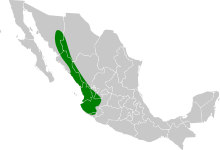
The Mexican jay formerly known as the gray-breasted jay, is a New World jay native to the Sierra Madre Oriental, Sierra Madre Occidental, and Central Plateau of Mexico and parts of the southwestern United States. In May 2011, the American Ornithologists' Union voted to split the Mexican jay into two species, one retaining the common name Mexican jay and one called the Transvolcanic jay. The Mexican jay is a medium-sized jay with blue upper parts and pale gray underparts. It resembles the Woodhouse's scrub-jay, but has an unstreaked throat and breast. It feeds largely on acorns and pine nuts, but includes many other plant and animal foods in its diet. It has a cooperative breeding system where the parents are assisted by other birds to raise their young. This is a common species with a wide range and the International Union for Conservation of Nature has rated its conservation status as being of "least concern".

The white-throated magpie-jay is a large Central American species of magpie-jay. It ranges in Pacific-slope thorn forest from Jalisco, Mexico, to Guanacaste, Costa Rica. Magpie-jays are noisy, gregarious birds, often traveling in easy-to-find flocks, mobbing their observers.
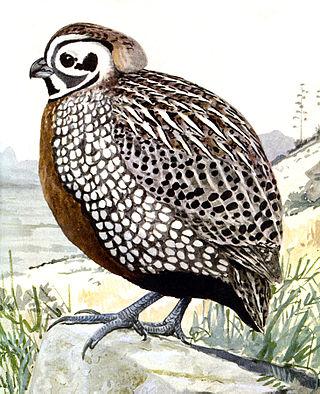
The Montezuma quail is a stubby, secretive New World quail of Mexico and some nearby parts of the United States. It is also known as Mearns's quail, the harlequin quail, and the fool quail.

The pale-headed rosella, is a broad-tailed parrot of the genus Platycercus native to northeastern Australia. It is a moderate-size parrot with a pale yellow head, predominantly white cheeks, scalloped black and gold back and pale blue underparts. Two subspecies are recognised, although some authorities consider it to be conspecific with the eastern rosella of southeastern Australia.
Dr Alexander Collie was a Scottish surgeon and botanist who journeyed to Western Australia in 1829, where he was an explorer and Colonial Surgeon.

The purple-naped lory is a species of parrot in the family Psittaculidae. It is forest-dwelling endemic to the islands of Seram, Ambon, and perhaps also Haruku and Saparua, South Maluku, Indonesia. It is considered endangered, the main threat being from trapping for the cage-bird trade.
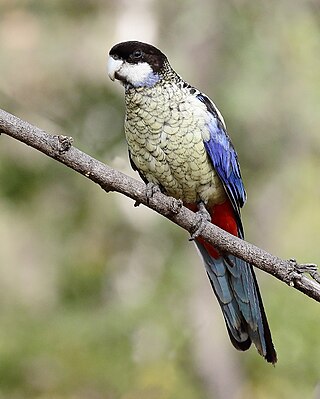
The northern rosella, formerly known as Brown's rosella or the smutty rosella, is a species of parrot native to northern Australia, ranging from the Gulf of Carpentaria and Arnhem Land to the Kimberley. It was described by Heinrich Kuhl in 1820, and two subspecies are recognised. The species is unusually coloured for a rosella, with a dark head and neck with pale cheeks—predominantly white in the subspecies from the Northern Territory and blue in the Western Australian subspecies hillii. The northern rosella's mantle and scapulars are black with fine yellow scallops, while its back, rump and underparts are pale yellow with fine black scallops. The long tail is blue-green, and the wings are black and blue-violet. The sexes have similar plumage, while females and younger birds are generally duller with occasional spots of red.
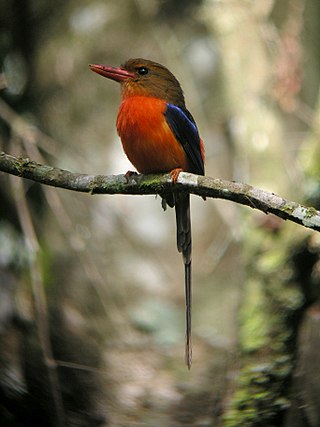
The brown-headed paradise kingfisher, also known as the russet paradise kingfisher, is a species of bird in the family Alcedinidae. It is endemic to the lowland forest in the Bird's Tail Peninsula. Its natural habitats are temperate forests and subtropical or tropical moist lowland forests. Like all paradise kingfishers this bird has colourful plumage with a red bill and distinctive long tail streamers. No subspecies are distinguished.

The common paradise kingfisher, also known as the Galatea paradise kingfisher and the racquet-tailed kingfisher, is a species of bird in the family Alcedinidae. It is found in subtropical or tropical moist lowland forests of the Maluku Islands and New Guinea. Like all paradise kingfishers, it has a red bill and colourful plumage. The species is common and the IUCN has assessed its conservation status as being of "least concern".

The San Blas jay is a species of bird in the family Corvidae. It is endemic to Mexico where its natural habitat is subtropical or tropical dry forests; it is a common species and has been rated as "least concern" by the IUCN.

Myiagra is a genus of passerine birds in the family Monarchidae, the monarch flycatchers, native to Australasia, sometimes referred to as the broad-billed flycatchers or simply broadbills.
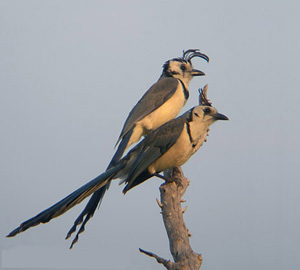
The magpie-jays are a genus, Calocitta, of the family Corvidae native to the southern part of North America. Sometimes placed in the genus Cyanocorax. The two known species are known to form hybrids.

The Bajío dry forests is a tropical dry broadleaf forest ecoregion in western−central Mexico.

Psittacara is a genus of parakeets in the tribe Arini. Species of the genus are found in Central and South America, the Caribbean and one species reaching the southern United States. Until 2013, all the species were placed in the genus Aratinga. Many of the Psittacara species are kept in aviculture or as companion parrots, where they are commonly known as conures.

The black-capped paradise kingfisher or black-headed paradise kingfisher, is a bird in the tree kingfisher subfamily, Halcyoninae. It is native to several islands in the Bismarck Archipelago to the east of New Guinea. Like all paradise kingfishers, this bird has colourful plumage with a red bill and long distinctive tail streamers.
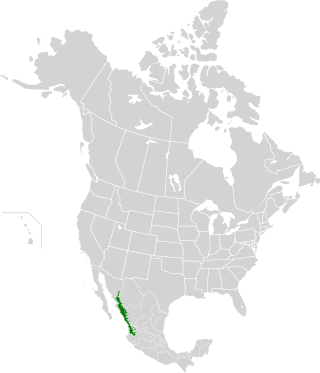
The Sinaloan dry forests is a tropical dry broadleaf forest ecoregion in western Mexico. It is the northernmost ecoregion of the Neotropical realm.

La Primavera Biosphere Reserve, also known as La Primavera Flora and Fauna Protection Area, is a protected natural area in western Mexico. It is located in the state of Jalisco, immediately west of the city of Guadalajara.

